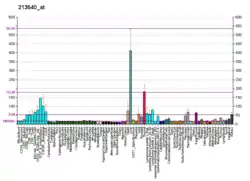HSD17B8
Estradiol 17 beta-dehydrogenase 8 is an enzyme that in humans is encoded by the HSD17B8 gene.[5][6][7]
| HSD17B8 | |||||||||||||||||||||||||||||||||||||||||||||||||||
|---|---|---|---|---|---|---|---|---|---|---|---|---|---|---|---|---|---|---|---|---|---|---|---|---|---|---|---|---|---|---|---|---|---|---|---|---|---|---|---|---|---|---|---|---|---|---|---|---|---|---|---|
 | |||||||||||||||||||||||||||||||||||||||||||||||||||
| |||||||||||||||||||||||||||||||||||||||||||||||||||
| Identifiers | |||||||||||||||||||||||||||||||||||||||||||||||||||
| Aliases | HSD17B8, D6S2245E, FABG, FABGL, H2-KE6, HKE6, KE6, RING2, SDR30C1, dJ1033B10.9, hydroxysteroid (17-beta) dehydrogenase 8, hydroxysteroid 17-beta dehydrogenase 8 | ||||||||||||||||||||||||||||||||||||||||||||||||||
| External IDs | OMIM: 601417 MGI: 95911 HomoloGene: 56588 GeneCards: HSD17B8 | ||||||||||||||||||||||||||||||||||||||||||||||||||
| EC number | 1.1.1.239 | ||||||||||||||||||||||||||||||||||||||||||||||||||
| |||||||||||||||||||||||||||||||||||||||||||||||||||
| |||||||||||||||||||||||||||||||||||||||||||||||||||
| |||||||||||||||||||||||||||||||||||||||||||||||||||
| |||||||||||||||||||||||||||||||||||||||||||||||||||
| |||||||||||||||||||||||||||||||||||||||||||||||||||
| Wikidata | |||||||||||||||||||||||||||||||||||||||||||||||||||
| |||||||||||||||||||||||||||||||||||||||||||||||||||
In mice, the Ke6 protein is a 17-beta-hydroxysteroid dehydrogenase that can regulate the concentration of biologically active estrogens and androgens. It is preferentially an oxidative enzyme and inactivates estradiol, testosterone, and dihydrotestosterone. However, the enzyme has some reductive activity and can synthesize estradiol from estrone. The protein encoded by this gene is similar to Ke6 and is a member of the short-chain dehydrogenase superfamily. An alternatively spliced transcript of this gene has been detected, but the full-length nature of this variant has not been determined.[7]
References
- ENSG00000228357, ENSG00000225312, ENSG00000232357, ENSG00000112474, ENSG00000228712 GRCh38: Ensembl release 89: ENSG00000204228, ENSG00000228357, ENSG00000225312, ENSG00000232357, ENSG00000112474, ENSG00000228712 - Ensembl, May 2017
- GRCm38: Ensembl release 89: ENSMUSG00000073422 - Ensembl, May 2017
- "Human PubMed Reference:". National Center for Biotechnology Information, U.S. National Library of Medicine.
- "Mouse PubMed Reference:". National Center for Biotechnology Information, U.S. National Library of Medicine.
- Ando A, Kikuti YY, Shigenari A, Kawata H, Okamoto N, Shiina T, Chen L, Ikemura T, Abe K, Kimura M, Inoko H (Dec 1996). "cDNA cloning of the human homologues of the mouse Ke4 and Ke6 genes at the centromeric end of the human MHC region". Genomics. 35 (3): 600–2. doi:10.1006/geno.1996.0405. PMID 8812499.
- Persson B, Kallberg Y, Bray JE, Bruford E, Dellaporta SL, Favia AD, Duarte RG, Jornvall H, Kavanagh KL, Kedishvili N, Kisiela M, Maser E, Mindnich R, Orchard S, Penning TM, Thornton JM, Adamski J, Oppermann U (Feb 2009). "The SDR (Short-Chain Dehydrogenase/Reductase and Related Enzymes) Nomenclature Initiative". Chem Biol Interact. 178 (1–3): 94–8. doi:10.1016/j.cbi.2008.10.040. PMC 2896744. PMID 19027726.
- "Entrez Gene: HSD17B8 hydroxysteroid (17-beta) dehydrogenase 8".
Further reading
- Kikuti YY, Tamiya G, Ando A, et al. (1997). "Physical mapping 220 kb centromeric of the human MHC and DNA sequence analysis of the 43-kb segment including the RING1, HKE6, and HKE4 genes". Genomics. 42 (3): 422–35. doi:10.1006/geno.1997.4745. PMID 9205114.
- Fomitcheva J, Baker ME, Anderson E, et al. (1998). "Characterization of Ke 6, a new 17beta-hydroxysteroid dehydrogenase, and its expression in gonadal tissues". J. Biol. Chem. 273 (35): 22664–71. doi:10.1074/jbc.273.35.22664. PMID 9712896.
- Hartley JL, Temple GF, Brasch MA (2001). "DNA Cloning Using In Vitro Site-Specific Recombination". Genome Res. 10 (11): 1788–95. doi:10.1101/gr.143000. PMC 310948. PMID 11076863.
- Aziz N, Anderson E, Lee GY, Woo DD (2001). "Arrested testis development in the cpk mouse may be the result of abnormal steroid metabolism". Mol. Cell. Endocrinol. 171 (1–2): 83–8. doi:10.1016/S0303-7207(00)00390-7. PMID 11165015. S2CID 20566396.
- Kutsenko AS, Gizatullin RZ, Al-Amin AN, et al. (2002). "NotI flanking sequences: a tool for gene discovery and verification of the human genome". Nucleic Acids Res. 30 (14): 3163–70. doi:10.1093/nar/gkf428. PMC 135748. PMID 12136098.
- Strausberg RL, Feingold EA, Grouse LH, et al. (2003). "Generation and initial analysis of more than 15,000 full-length human and mouse cDNA sequences". Proc. Natl. Acad. Sci. U.S.A. 99 (26): 16899–903. Bibcode:2002PNAS...9916899M. doi:10.1073/pnas.242603899. PMC 139241. PMID 12477932.
- Mungall AJ, Palmer SA, Sims SK, et al. (2003). "The DNA sequence and analysis of human chromosome 6". Nature. 425 (6960): 805–11. Bibcode:2003Natur.425..805M. doi:10.1038/nature02055. PMID 14574404.
- Gerhard DS, Wagner L, Feingold EA, et al. (2004). "The Status, Quality, and Expansion of the NIH Full-Length cDNA Project: The Mammalian Gene Collection (MGC)". Genome Res. 14 (10B): 2121–7. doi:10.1101/gr.2596504. PMC 528928. PMID 15489334.
- Wiemann S, Arlt D, Huber W, et al. (2004). "From ORFeome to Biology: A Functional Genomics Pipeline". Genome Res. 14 (10B): 2136–44. doi:10.1101/gr.2576704. PMC 528930. PMID 15489336.
- Mehrle A, Rosenfelder H, Schupp I, et al. (2006). "The LIFEdb database in 2006". Nucleic Acids Res. 34 (Database issue): D415–8. doi:10.1093/nar/gkj139. PMC 1347501. PMID 16381901.
- Song D, Liu G, Luu-The V, et al. (2006). "Expression of aromatase and 17beta-hydroxysteroid dehydrogenase types 1, 7 and 12 in breast cancer. An immunocytochemical study". J. Steroid Biochem. Mol. Biol. 101 (2–3): 136–44. doi:10.1016/j.jsbmb.2006.06.015. PMID 16930994. S2CID 27619774.
- Villar J, Celay J, Alonso MM, et al. (2007). "Transcriptional regulation of the human type 8 17beta-hydroxysteroid dehydrogenase gene by C/EBPbeta". J. Steroid Biochem. Mol. Biol. 105 (1–5): 131–9. doi:10.1016/j.jsbmb.2006.12.106. PMID 17583490. S2CID 54404567.
This article is issued from Wikipedia. The text is licensed under Creative Commons - Attribution - Sharealike. Additional terms may apply for the media files.





